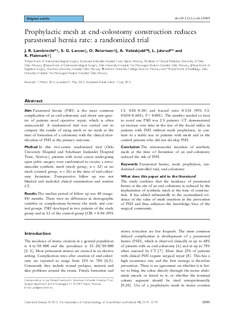Prophylactic mesh at end-colostomy construction reduces parastomal hernia rate: a randomized trial
Lambrecht, Jan Roland; Larsen, Stein Gunnar; Reiertsen, Ola; Vaktskjold, Arild; Julsrud, Lars; Flatmark, Kjersti
Journal article, Peer reviewed
Permanent lenke
http://hdl.handle.net/11250/2418552Utgivelsesdato
2015Metadata
Vis full innførselSamlinger
Sammendrag
AimParastomal hernia (PSH) is the most common complication of an end-colostomy and about one-quarter of patients need operative repair, which is often unsuccessful. A randomized trial was carried out to compare the results of using mesh or no mesh at the time of formation of a colostomy with the clinical identification of PSH as the primary outcome.
MethodIn this two-centre randomized trial (Oslo University Hospital and Sykehuset Innlandet Hospital Trust, Norway), patients with rectal cancer undergoing open pelvic surgery were randomized to receive a retromuscular synthetic mesh (study group, n = 32) or no mesh (control group, n = 26) at the time of end-colostomy formation. Postoperative follow up was not blinded and included clinical examination and routine CT.
ResultsThe median period of follow up was 40 (range: 84) months. There were no differences in demographic variables or complications between the study and control groups. PSH developed in two patients of the study group and in 12 of the control group [OR = 0.04 (95% CI: 0.01–0.30) and hazard ratio 0.134 (95% CI: 0.030–0.603); P < 0.001]. The number needed to treat to avoid one PSH was 2.5 patients. CT demonstrated an increase over time in the size of the fascial orifice in patients with PSH without mesh prophylaxis, in contrast to a stable size in patients with mesh and in the control patients who did not develop PSH.
ConclusionThe retromuscular insertion of synthetic mesh at the time of formation of an end-colostomy reduced the risk of PSH
Beskrivelse
-
